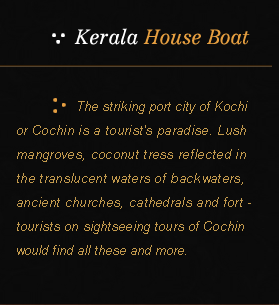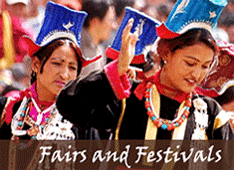Home > North India Tour Packages > Classical India with Amritsar & Shimla

Duration : 16 Days & 15 Nights
Location : Delhi – Amritsar – Shimla – Delhi – Varanasi – Khajuraho – Agra – Jaipur – Delhi.
Location : Delhi – Amritsar – Shimla – Delhi – Varanasi – Khajuraho – Agra – Jaipur – Delhi.
Day 01
Delhi Arrival:
COMPANY REPRESENTATIVE will receive you on arrival at the DELHI AIRPORT and transfer to your hotel.
DELHI, the capital of kingdoms and empires is now a sprawling metropolis with a fascinating blend of the past and the present. It is a perfect introduction to the composite culture of an ancient land. A window to the kaleidoscope - that is India.
Overnight will be at Delhi.
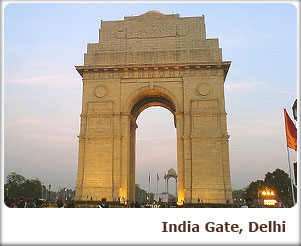 Day 02
Day 02
Delhi:
After breakfast proceed for a day sightseeing tour of the city.
The city is dotted with historic monuments that are the most popular tourist attractions in Delhi. Apart from the monuments, there are museums, markets, gardens and eating joints that you can visit on your tour of Delhi. Some of the important sightseeing places in Delhi are given below.
INDIA GATE: It is the war memorial dedicated to Indian soldiers, who died during World War I. The name of many soldiers who died during World War I is inscribed on its wall. Edward Lutyens, the man who planned and built New Delhi, designed India Gate. Almost every foreign tourist visits the monument. 'Amar Jawan Jyoti', the eternal flame is added later. The eternal flame runs on gas and is a tribute to soldiers who lost their lives in the service of the nation.
RED FORT: Located in Old Delhi, the Red Fort or Lal Quila is a popular tourist attraction in Delhi. The fort was built by the Mughal emperor Shah Jahan in 1648, when he moved his capital from Agra to Delhi. The construction of the Fort started in 1638 and it was completed 10 years later in 1648. Some of the important spots inside the Red Fort include royal baths or Shahi hamams, Shahi Burj, Moti Masjid or the Pearl Mosque, Diwan-e-Aam and Diwan-e-Khas.
JAMA MASJID: The largest mosque in India, the Jama Masjid was built by Shah Jahan 1656 AD. About 5,000 laborers and craftsmen worked for six years to complete the monument. The mosque can accommodate about 25,000 people. The mosque is located in the old Delhi. The domes are built in white marble. The prayer hall of the mosque has 260 pillars.
OLD FORT: Old Fort or Purana Quila as it is called is located near Pragati Maidan on the Mathura Road. You can club a visit to the Old Fort with your tour of Red Fort and Jama Masjid as the three monuments are located in Old Delhi and are not too far from one another. Humanyun’s started the construction of the fort in 1533 AD, but before the completion of the fort, Sher Shah Suri defeated him and captured Delhi. Sher Shah Suri completed the fort and named it -Shergah. He added many structures to the fort, of which Qila-I-Kuhna Mosque and Sher Mandal are worth mentioning. In 1555, Humanyun’s re-captured Delhi and converted Sher Mandal into a library.
HUMANYUN’S TOMB: Humanyun’s Tomb is mausoleum of the Mughal emperor Humanyun’s. Bega Begum also known as Haji Begum, wife of Humayun constructed the mausoleum for her husband. The tomb was built between 1562 and 1572 AD. The tomb was designed by Mirak Mirza Ghiyuth.
QUTAB MINAR: The construction of the Qutab Minar was stated by Qutub-ud-din Aibak in 1199 AD but he died before completing it. His son-in-law and successor Iltutmish completed the construction of the building. Qutab Minar is located in Meharauli.
LOTUS TEMPLE: Also known as the Bahai Temple, the monument was opened to public only in 1986. Located near Nehru Place, the Lotus Temple is designed like a lotus flower. If you are looking for some moments of peace and tranquility in the crowded city, Lotus Temple is the ideal place to visit.
Apart from the above-mentioned sightseeing options, there are various other tourist attractions that you can visit on your tour of Delhi. Some other sightseeing places in Delhi include Lodi Gardens, National Museum, Jantar Mantar, Dilli Haat and the Garden of Five Senses.
Overnight will be at Delhi.
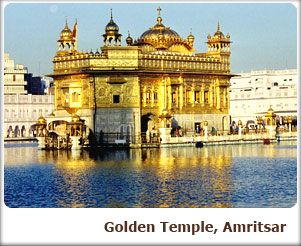 Day 03
Day 03
Delhi – Amritsar:
By Train
Train Name : Swarna Shatabdi
Train Number : 2029
Departure : 0720hrs
Arrival : 1325hrs
Early morning you will be transferred to the railway station to board train for Amritsar. Reach and check into the hotel.
Popularly believed to have been laid in 1574, the city of Amritsar is one of the most traveled tourist destinations in India due to the existence of several religious sites. It actually offers a host sightseeing options that are considered as some of the best tourist attractions in Amritsar.
Located in the North West region of India, the most striking feature about Amritsar is its antiquity. In Hindi the word Amritsar means 'a Holy pool of nectar' and it was back in the year 1573 that work for digging the Holy pool had begun. One of the ancient cities of India, the most important fact about Amritsar is that it is the main seat of Sikh history and culture. The city itself was founded by the Sikh Guru, Guru Ram Das, and till present times it is the spiritual and temporal center of Sikh culture with the Golden Temple in Amritsar as its nucleus.
Visit GOLDEN TEMPLE: Located in the heart of the city is the Golden Temple, the most visited tourist attraction of Amritsar. Characterized by its four entrance doors (called deoris) in all four directions and the tastefully decorated shrines, in terms of art and architecture, the Golden Temple welcomes everyone regardless of the religion or faith one follows. The stunning sanctum, shimmering in the water of the holy tank, flanked by spotlessly clean marble walkways and pavements makes it breathtakingly beautiful. It has four doorways and gorgeously decorated arches. Reflecting influences of both Hindu and Muslim styles of architecture, the temple standing in the middle of a tank, exudes tremendous architectural brilliance which draws the attention of numerous tourists around the globe.
Also called Sri Harmandir Sahib, the Golden Temple was laid by Guru Ram Das in the 14th century. It is acclaimed as one of the holiest sites of the Sikhs. The temple itself is topped by a golden dome contributed by Maharaja Ranjit Singh who had the shrine rebuilt. It came to be called the Golden Temple after this. Located in the heart of the atmospheric old quarter it can be easily reached via the shopping area of Hall Bazaar. Devotees wash their hands and feet, and cover their heads while entering the temple complex via Darshini Darwaza. They then do the 'parikrama' or the round of the smaller homage sites surrounding of the temple. The parikrama is a wide marbled passageway that encircles the sarovar.
Hall Gate is a great place to stock up on Pakistani jootis as is the Mochi Bazaar. Punjab is the heart of the 'jadau' jewellery business so if you're into traditional Indian jewellery check out Guru Bazaar. Textiles was big business in this city (try the shops at Katra Jaimal Singh near Hall Bazaar) and it continues to be a major centre for woollens and blankets; check the shops at Shastri Market. And for the famous pappad - vadis of Amritsar look no further than the Majith Mandi.
Overnight will be at Amritsar.
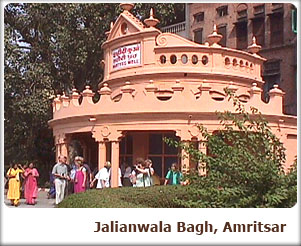 Day 04
Day 04
Amritsar:
Breakfast will be at the hotel.
Visit the INDIA PAKISTAN BORDER for a dress parade. (GATE OPENING CEREMONY)
WAGAH BORDER: One of the many nearby places to visit from Amritsar is the Wagah Border. Located on the Indo-Pakistan border, Wagah is 28 kilometers from the Amritsar main town. A good number of visitors come to this place to see the change of guard’s ceremony and the flag hoisting and lowering activities which are done with great skill and precision by the border security forces of both the countries. A site you cannot afford to miss.
JALIANWALA BAGH: A historical monument that tells the sad story of mass killing during the independence movement in India, Jalianwallah Bagh is another must visit in Amritsar. Here lies the memorial of the martyrs of the 1919 massacre by British General Dyer. Presently the place also has a park. The Martyr’s Gallery is open from 9 am to 5 pm in summers and from 10 am to 4 pm during winters.
SUMMER PALACE OF MAHARAJA RANJIT SINGH: Is situated in the middle of a beautiful garden called Ram Bagh. This garden is laid out on the pattern of Shalimar Bagh at Lahore. Only its architecturally unique ´Darshani Deori´ has remained intact. A museum after the name of the Maharaja is set up here displaying oil paintings, miniatures, coins, and weapons relating to the Sikh period.
DURGIANA TEMPLE: Set within a serene sarovar the 16th century temple's gilded visage reminds you of the Darbar Sahib. It is dedicated to the Goddess Durga. Within the complex devotees stop by at the Sheetla Mata Temple, Lakshmi Narayan Mandir and the Hanuman Mandir.
Food is the next best way to get under the skin of the city, especially its street offerings, cheap and tasty; they will spoil your taste buds thoroughly. On Maqbool Road line up for the legendary kulcha channa of All India Fame Amritsar Special Kulcha. Get there well before noon. For a full veg meal head for Bharawan Da Dhaba, close to the Golden Temple and order their legendary thalis. If non-veg is your thing it has to be Amritsari Macchi at Katra Sher Singh. For grilled chicken it's the famous Surjit Chicken House, just off Lawrence Road. Brijwasi Bhandar on Cooper Road has the best chaat in town. Wrap up your meal with the rich pinnis of Kanhaiya Lal. Else head for Katra Alluwalia for its yummy jalebis. The Guru Ka Langar at the Golden Temple serves simple but great home-cooked style veg meals.
Overnight will be at Amritsar.
Day 05
Amritsar – Ambala:
By Train
Train Name : Jan Shatabdi
Train Number : 2054
Departure : 0700hrs
Arrival : 1055hrs
Ambala – Shimla:
By Road 175Kms/04hrs
Early morning you will be transferred to the railway station to board train for Ambala. Reach Ambala and drive to Shimla. Reach Shimla and check into the hotel.
Shimla – the capital of Himachal Pradesh and former summer capital of British India, Shimla is the state’s most important centre. Bulging at its seams with unprecedented expansion, Shimla retains a colonial aura, with its grand old buildings. Shimla has spread along the seven hills around its original home on a ridge, with little regard for aesthetic or eco-friendly development. It no longer offers visitors the gentle flavors of the Raj era. But those who love Shimla, warts and all, can still find favored haunts that are not touched with the noisy exploits of the Mall crowd which seems to descend on the hill town year round now.
Overnight will be at Shimla.
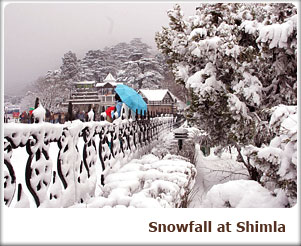 Day 06
Day 06
Shimla:
Breakfast will be at the hotel.
Explore the scenic places around Shimla
The Mall - It's the heartbeat of the hill town, love it or hate it you will still end up strolling down this notified 'Heritage Zone' of Shimla. Many of its colonial buildings may be replaced with high rise residential blocks and hotels and numerous restaurants along the way, but you'll still discover some of the old favorite’s here-Baljees, Diwan Chand, the Chinese shoemakers. And there's the tiny Gaiety Theatre, still in use. Rudyard Kipling, Amrita Shergill, Prithivraj Kapoor are just a few of the luminaries associated with the theatrics enacted here over time.
Lakkar Bazaar, is a popular hangout for the holiday crowd, as there are pony rides on offer and woodcraft to take home as souvenirs. At the top end of the Mall is Scandal Point, where the Maharaja of Patiala is said to have run off with a memsahib, causing a great 'scandal' amongst the British community. It is a large open square, packed with visitors now enjoying the views. Above the Rivoli Bus Stand you'll find the open air ice skating rink, which is thronged with visitors braving the winter chill from November to January.
Viceregal Lodge represented the negotiating grounds for the end of British rule and the partition of India. Set upon the green environs of Observatory Hill, it was from this lavish setting that the Raj ruled India in summers. It is now the home of the Indian Institute of Advanced Studies. Visitors are permitted to see the first floor which has a small museum and a main hall.
Himachal State Museum; A short walk up Inevram Hill close to the Viceregal Lodge the museum has a fine collection Pahari miniatures, manuscripts, local handicrafts, textiles, stone sculpture, and embroidery.
Bazaar: The Chotta Shimla bazaar is awash with fruit sellers, small eateries and Tibetans's hawking sweaters shawls and sundry souvenir items.
Overnight will be at Shimla.
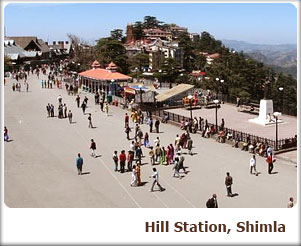 Day 07
Day 07
Shimla:
After breakfast proceed for the sightseeing.
Mashobra (14 km): Mashobra's serene environs is perfect for walks or a comfortable drive to the lovely green glen of Craignano. The Raj serial, Jewel In the Crown was filmed by the Merchant-Ivory film company at Sunderban owned by Sir Sobha Singh's son General Gurbax Singh. Naldehra, a short drive away has a lovely golf course and you can play a game if you get a free slot, for a nominal green fee. The walks around the golf course are not too steep and can be quite pleasant for all age groups.
Jakhoo Hill: It's a hard hike up to Shimla's highest point. Be wary of the hordes of monkeys that periodically waylay unsuspecting visitors wending their way to the Jakhoo Temple. It is dedicated, appropriately to Lord Hanuman. Enjoy some fine views from this lofty perch. Christ Church, Shimla's most famous landmark is located here. It has some beautiful stained glass windows. From Elysium Hill, located behind Jakhoo Hill, you get great views of the Shimla hills and the hill town.
Overnight will be at Shimla.
Day 08
Shimla – Kalka:
By Toy Train
Kalka – Delhi:
By Train
Train Name : Kalka Shatabdi
Train Number : 2012
Departure : 1745hrs
Arrival : 2155hrs
Breakfast will be at the hotel.
Spend the day in leisure.
Transfer to railway station to board train for Delhi. Reach Delhi and check into the hotel.
Overnight will be at Delhi.
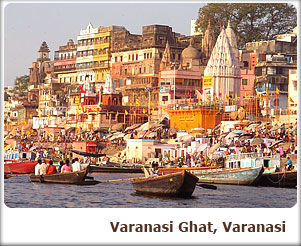 Day 09
Day 09
Delhi – Varanasi:
By Air
Breakfast will be at hotel.
Transfer in time to airport for flight to Varanasi. Upon arrival at Varanasi, you will be met and transferred to hotel.
Picturesquely situated on the crescent shaped left bank of the holy River Ganges, Varanasi, one of the ancient seats of learning in India, is said to be a compound of the names of two streams, the Varuna and the Assi, which still flow in the north and south of the city respectively. This name seems to have been corrupted, in medieval times to Varanasi, which was in use till May 1956, when it was changed to Varanasi, by an order of the Government of India. Varanasi is probably one of the most ancient living cities in India. From time immemorial it has been a great religious center for Hindus and one of their most sacred places of pilgrimage, being visited by millions of people every year. To every visitor Varanasi offers a breathtaking experience. The rays of the dawn shimmering across the Ganges; the high-banks; the temples and shrines along the banks bathed in a golden hue …soul stirring hymns and mantras along with the fragrance of incense filling the air…and the refreshing dip in the holy waters gently splashing at the Ghats. Varanasi – The land where experience and discovery reach the ultimate bliss. Varanasi is also renowned for its rich tapestry of music, arts, crafts and education. Some of the world – renowned exponents India has produced in these fields were schooled in Varanasi’s cultural ethos. Luminaries apart, Varanasi abounds in the art of silk weaving, an exotic work of art which manifests itself in precious Banarasi silk sarees and silk brocades which are cherished as collector’s items across the world today.
Enjoy the evening AARTI at the GHATS. The guide will be giving a commentary to you on the proceedings and meanings of the chants during the AARTI of the river.
Later spend the evening shopping in the lanes of Varanasi.
Overnight will be at Varanasi.
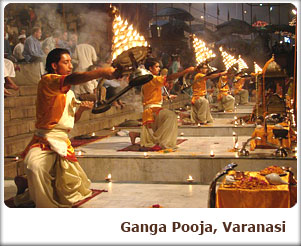 Day 10
Day 10
Varanasi:
Proceed in the morning to Daswamedh Ghat and take a boat ride on the sacred river Ganges to see the cremation Ghats and witness the living traditions of one of the world's oldest and most important religions.
Cruise the Ganges. Perhaps the best way to enjoy the site of Varanasi’s Ghats is a cruise along the river at dawn. Hundreds of bathers, worshippers performing religious rites, holy men practicing yoga and people washing clothes gather at the river’s banks. (To start at 0500 hrs. for the best lifetime experience) For you to appreciate this remarkable city, we’ll transfer you to the banks of the River Ganges before the sun rises. Board a boat with your guide and proceed to the middle of the river, where at sunrise the sight unfolds before you. Thousands of faithful come daily to the banks to bathe and pray while in the background, temples and palaces rise in tiers from the water’s edge. Return for a walk through the cobblestone streets along the banks of "Ganga". As shops are opening, the place now becomes a beehive of activity as the faithful are coming and going.
Return to hotel for a sumptuous breakfast.
Proceed for the sightseeing.
Bharat Mata Mandir: Bharat Mata Mandir or Bharat Mata Temple is one of its kinds in Varanasi. Contrary to what most of the tourists believe, this temple is not dedicated to any God, Goddess or certain deity for that matter. It is dedicated to the human manifestation of India popularly called Mother India or Bharat Mata in Hindi. The temple was inaugurated by non other than Mahatma Gandhi, The father of the Indian Nation.
Banaras Hindu University: BHU was built in the year 1916-1917 under the special act of parliament passed in the year 1915 named BHU act. The act was passed by the interim parliament that worked under the imperial British government. Mahamna Pundit Madan Mohan Malaviya and Annie Besant did the conceptualization and implementation of this university. Raja of Kashi donated 1350 acres of land for the construction of the sprawling campus.
Durga Mandir: Goddess Durga is a significant manifestation of Parvati, the consort of Lord Shiva. In fact she is said to be Shakti, or the manifestation of Parvati that signifies the female element of Power and harmony in nature. This is precisely because a Bengali Maharani built this temple in the 18th century.
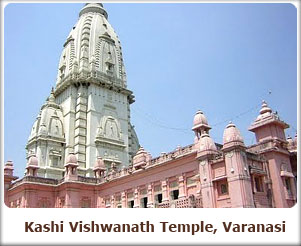 Kashi Vishwanath Mandir: The Vishwanath temple is synonymous to Varanasi. Vishwanath Temple is the most sacred and the most famous temple in Varanasi. In fact, Vishwanath Temple is extremely popular in other parts of India too. A considerable chunk of foreign visitors in India come to Varanasi every year to get a glimpse of the Vishwanath Temple even though the followers of Semitic religions are not allowed to enter the sanctum of the temple.
Kashi Vishwanath Mandir: The Vishwanath temple is synonymous to Varanasi. Vishwanath Temple is the most sacred and the most famous temple in Varanasi. In fact, Vishwanath Temple is extremely popular in other parts of India too. A considerable chunk of foreign visitors in India come to Varanasi every year to get a glimpse of the Vishwanath Temple even though the followers of Semitic religions are not allowed to enter the sanctum of the temple.
Tulsi Manas Mandir: Tulsi Manas Temple has a very historical as well as cultural importance for not only Varanasi but also for the whole of India. This is because Ramayana was composed at this very place. Goswami Tulsi Das was the man who composed Ramayana in Hindi in the form of "Ram Charit Manas".
Visit Sarnath 5 miles out of Varanasi: The great Buddha enhanced the sanctity of Varanasi by choosing the environs of the city to preach his first sermon at Sarnath, (only 10 Kms away) after attaining enlightenment. Later, Ashoka, the great Mauryan Emperor erected magnificent stupas and other buildings along with his mighty stone pillar, Dharmarajika Stupa. The 110 ft. tall Damekh Stupa marks the place where Buddha preached first sermon. Sarnath has been a premier centre for Buddhism. It is a rich collection of ancient Buddhist relics and antiques comprising numerous Buddha and Bodhisatva images on display at the Archaeological Museum (1000 hrs to 1700 hrs. Open all days except Friday)
Overnight will be at Varanasi.
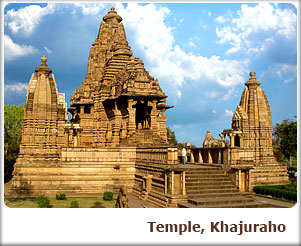 Day 11
Day 11
Varanasi – Khajuraho:
By Air
Breakfast will be at the hotel.
Proceed to the airport for flight to Khajuraho. Reach and check into the hotel.
Khajuraho, which has lent its name to a complex of exquisite Hindu and Jain temples, is a small town located amidst the forested plains of Bundelkhand in north-central Madhya Pradesh. The beautiful temples that dot Khajuraho are believed to have been built by the mighty Chandela rulers in the 9th and 10th century AD. The engravings on these temples are highly sensual and erotic that depicts in graceful forms intimate scenes of the whole range of human emotions and relationships. These sculptures congeal in stone a lyrical paean to love and passion and reflect the Chandela dynasty/’s immense appreciation for art.
Architecturally, the temples are built in the north Indian Nagara style. The sculptor/’s fine skill and a sense of imagination have given form to human emotion in the form of spiritual and physical love. Every façade—wall, window, pillar, and ceiling—is carved with figures of mythical and historical origins, and while many of these depict full-breasted, girdle-waisted women in forms of innocent play, they also depict carnal love.
Khajuraho combines history, architecture, culture and environment with delectable charm. It is a town that takes you away from the noise and pollution of the city, with its fresh air and scenic countryside. For convenience, the temples of Khajuraho are divided into the Western, Eastern, and Southern groups. The Western Group, situated opposite the Government of India Tourist Office, has 14 temples. The Chaunsath Yogini, Lalguan Mahadev, Parvati, Varaha, Matangesvara, Lakshmana, Vishvanath and Nandi, Chitragupta, Devi Jagdamba and Kandariya Mahadeo temples belong to this group. The Eastern Group, 2.4 km from the Tourist Office, consists of seven temples (four Jain and three Hindu). The Parsvanath, Adinath, Shantinath, and Ghantai temples belong to the Jains while the Vamana, Javari and Brahma are Hindu temples. The Southern Group, about 5 km from Khajuraho, contains the Chaturbhuj and Duladeo temples.
Visit the WESTERN SET OF TEMPLES.
Enjoy the Light and Sound show in the evening.
Overnight will be at Khajuraho.
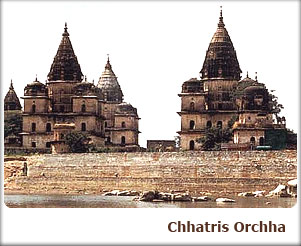 Day 12
Day 12
Khajuraho – Orchha - Jhansi;
By Road 175Kms/04hrs
Jhansi – Agra
By Deluxe train
Enjoy breakfast at the hotel.
Visit the EASTERN SET OF TEMPLES.
Drive to Jhansi railway station visiting Orchha enroute.
ORCHHA - The grandeur and opulence of the former Bundela dynasty is well reflected in Orchha set amidst the flat Bundelkhand countryside. Built by Raja Rudra Pratap on an artificial island on Betwa river, Orchha (17 Km from Jhansi) takes you back to a royal era when Bundela rulers enjoyed the finer things of life cocooned in the comforts of their citadel. Orchha is a photographer's delight. With its forts, regal palaces, striking temples and chattris, it narrates a beautiful medieval tale.
Transfer to JHANSI station after early lunch for SUPERFAST SHATABDI EXPRESS to Agra. Reach Agra at 2000 hr. Reach and check in at hotel.
AGRA: Two great Mughal monarchs, Akbar and Shah Jahan, transformed the little village of Agra into a befitting second capital of the Mughal Empire – giving it the name Dar-ul-Khilafat {seat of the Emperor}. Today a visitor to Agra is caught up in a world of contrasting edifices, of red sandstone and white marble, narrow galleys and quaint buggies, and that irresistible charm that this favorite city of the Mughals still retains. It is not surprising, that modern Agra still reflects its Mughal heritage most conspicuously. A walk down the narrow bustling streets of the city will introduce the visitor to the wafting aroma of Mughlai cuisine.
Overnight stay will be at Agra.
Day 13
Agra:
After breakfast proceed for day sightseeing of Agra.
THE TAJ MAHAL – AN EMPEROR’S LAMENT: Agra is the city of the Taj Mahal. It is a sublime experience of the greatest love story ever told. Today India's most fascinating and beautiful masterpiece, this perfectly symmetrical edifice is set amidst landscaped gardens on the banks of the Yamuna River. The Taj was built by the Mughal Emperor Shahjahan as a memorial to his wife, Mumtaz Mahal. After her untimely death, Shah Jahan had her mortal remains buried in this mausoleum. And after his own demise he was placed to rest next to his beloved queen in the same mausoleum. Under the dome, below the ground level, in a dimly lit chamber, lie the mortal remains of Shahjahan and his beloved queen Mumtaz, reminding the world of their undying love. The Taj remains closed for visitors on Friday
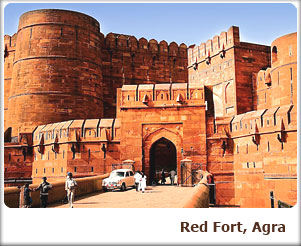 AGRA FORT – ARCHITECTURAL WONDER IN STONE: Within a radius of 3 kilometers, on the banks of the river Yamuna raises the crescent like Agra Fort. Designed and built by Akbar in 1565 A.D., the fort is surrounded by a 70 feet high wall. It houses the beautiful Pearl Mosque and numerous palaces including the Jahangir Mahal, Diwan-i-Khas, Diwan-i-Am and Moti Masjid. Later it was used by his son Jahangir also as the seat of power. Shahjahan modeled his creation, the Red Fort at Delhi on this fort. The Agra fort happens to be on the same bank of the river Yamuna as the Taj Mahal which is visible in all its beauty from one side of the fort. So very ironically, Shahjahan, a prisoner of his son Aurangzeb in his old age was put in a cell from where he could gaze at the Taj Mahal at a distance, from his cell in the Agra Fort.
AGRA FORT – ARCHITECTURAL WONDER IN STONE: Within a radius of 3 kilometers, on the banks of the river Yamuna raises the crescent like Agra Fort. Designed and built by Akbar in 1565 A.D., the fort is surrounded by a 70 feet high wall. It houses the beautiful Pearl Mosque and numerous palaces including the Jahangir Mahal, Diwan-i-Khas, Diwan-i-Am and Moti Masjid. Later it was used by his son Jahangir also as the seat of power. Shahjahan modeled his creation, the Red Fort at Delhi on this fort. The Agra fort happens to be on the same bank of the river Yamuna as the Taj Mahal which is visible in all its beauty from one side of the fort. So very ironically, Shahjahan, a prisoner of his son Aurangzeb in his old age was put in a cell from where he could gaze at the Taj Mahal at a distance, from his cell in the Agra Fort.
The fort has four gates and is enclosed by a double barricaded wall of red sand stone. Many buildings were constructed within the fort of which very few remain till date. One of the most significant ones is the multi storied Jahangir Mahal built by Akbar for his wife Jodha Bai.
The Mahal is reached through an impressive gateway and its inner courtyard consists of beautiful halls, profuse carvings on stone, exquisitely carved heavy brackets, piers and cross beams.
SIKANDRA: Sikandra, 10 Kms North West of Agra, is the final resting place of Emperor Akbar. The Tomb of Akbar shows an interesting fusion of Hindu and Mughal architecture reflecting the spirit of the Mughal Emperor Akbar. Akbar began the construction of his own garden mausoleum during his lifetime, a red sandstone structure in a char-Bagh meaning 4-square formal garden.
ITMAD – UL – DAULAH’A TOMB: This tomb was erected by Nur Jahan in sweet memory of her father Ghiasud-Din-Beg between 1622 - 1628 A.D. This white marble structure of the pre-Taj era though smaller is often considered equal if not better to the great one itself.
Overnight will be at Agra.
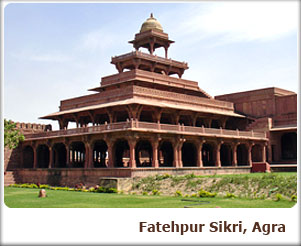 Day 14
Day 14
Agra – Fatehpur Sikri - Jaipur:
By Road 265kms/05hrs
Breakfast will be at hotel.
Drive to Jaipur visiting Fatehpur Sikri enroute.
FATEHPUR SIKRI – THE CITY OF VICTORY: 37 Kms from the city of Agra, stands Fatehpur Sikri, Akbar’s capital. Full credit goes to the Archeological Survey of India for this perfectly preserved example of a Mughal city at the height of the empire’s splendor. It is an attraction no visitor to Agra should miss. This sprawling structure is made of red sandstone and combines both Hindu and Mughal architecture. This walled city contains the mausoleum of the Sufi fakir, Saleem Chisti who is said to have granted Akbar and his Hindu queen Jodhabai their wish for a son. The main entrance to Fatehpur Sikri is through the 175 feet Buland Darwaza, the highest gateway in the world. It was built by Akbar to commemorate his victory over Khandesh in Gujarat.
The Panch Mahal is a five-storeyed tower, the highest point in Fatehpur Sikri. This extremely airy tower is supposed to have been used by one of the emperor's many queens.
After lunch continue drive to beautiful Pink City – Jaipur. Reach and check in at hotel.
Jaipur is the capital of the state of Rajasthan a romantic realm of resplendent palaces, mighty fortresses and regal Maharajahs that lies in the western deserts and is an utterly unique part of India. Proudly belonging to the KSHATRIYA warrior caste and fiercely independent, the Rajput princes made fearsome foes. However, many of them realized that to maintain their wealth and authority locally, it was expedient to proclaim allegiance to the central power. Thus, many enjoyed a privileged position under the Mughal emperors and also the British Raj that followed.
The bustling Rajasthan capital of Jaipur takes its name from its venerated founder Jai Singh II, who was given the title Sawai Maharaja by the Mughal. Literally translated this would mean ’one and a quarter’, suggesting that the Mughal thought this emperor to be more valuable than just ‘one’. Jaipur is known as the ’Pink City’ on account of the distinctive colour of its buildings. This did not, however, form part of the original plan, but dates back to 1856, when the city was given a wash of pink in honor of a State Visit from Prince Albert.
This evening, visit the Birla Temple to learn more about the fascinating religious life of Jaipur. The marble structure, built as recently as 1985, houses ornate statues including one of Lakshmi (goddess of Wealth and Beauty) and Narayan dressed in gaudy robes, representing a Hindu vision of heavenly luxury. Carvings in the temple and on pillars supporting the covered walkways include images of the Hindu pantheon, as well as Jesus, the Blessed Virgin Mary and St Francis of Assisi. Your visit will coincide with the AARTI Ceremony, which involves oil lamps being lit and waved, in order to awake and invoke the deity.
Enjoy the experience and spend night at Jaipur.
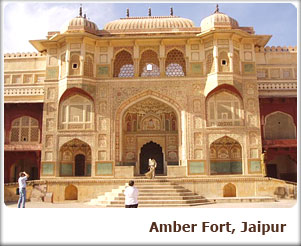 Day 15
Day 15
Jaipur:
After breakfast drive to Amber Palace. Enjoy Elephant Back ascent to the Fort.
AMER PALACE & FORT: Amer Fort and Palace was originally built by Raja Man Singh and subsequently developed by Sawai Jai Singh. The major attractions are Sheela Devi Temple, Sheesh Mahal (Hall of mirrors), Jai Garh Fort a few kilometers from the city centre was built for the defence of the town and has one of the world’s biggest cannons on wheels and a rich collection of arms and weapons.
Continue city sightseeing.
HAWA MAHAL (PALACE OF WINDS): Hawa Mahal is the most strikingly designed monument in Jaipur. Built by the Poet-King Sawai Pratap Singh in 1799, the Hawa Mahal is centrally located and is multiniched five storey high back view of the compled. It was conceived to provide an adequate vantage position behind delicate stone-carved jali, screens for the palace women to watch the royal processions passing through the Bazar below without being seen by outsiders. The Top of the palace affords a beautiful view of the city. A small archaeological museum is yet another attraction in the palace.
JAL MAHAL: The Jal Mahal Palace, Jaipur is noted for its intricate architecture. The Palace was developed as a pleasure spot. It was used for the royal duck shooting parties. On the road to Amber at a distance of 6.5 Kms from Jaipur are the cenotaphs of the royal family. A causeway leads to Jal Mahal Palace situated in the middle of Man Sagar Lake, opposite the cenotaphs. The first four floors of this building is under water, only the top floor remains outside. One can have a wonderful view of the lake and the palace from Nahar Garh Fort Built in 1799, the palace is now abandoned, but reasonably well preserved. In the monsoons, it looks particularly startling with its red sandstone set against the water hyacinth filled lake.
THE CITY PALACE: The city Palace is a historic landmark. The Carved arches are supported by grey-white marble columns studded with floral motifs in gold and colored stones. Two elephants carved in marble, guard the entrance, where retainers whose families have served generations of the rulers are at hand, to serve as guides.
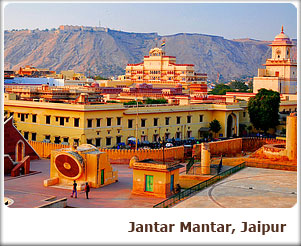 JANTAR MANTAR Jantar Mantar is one of Sawai Jai Singh’s five remarkable observatories. Constructed with stone and marble its compled instruments, whose setting and shapes are precisely and scientifically designed, represent the high-points of medieval Indian Astronomy. The two Ram Yantras used for gauging altitudes are unique in their isolation. This is the largest of five observatories founded by Sawai Jai Singh-II in various parts of the country.
JANTAR MANTAR Jantar Mantar is one of Sawai Jai Singh’s five remarkable observatories. Constructed with stone and marble its compled instruments, whose setting and shapes are precisely and scientifically designed, represent the high-points of medieval Indian Astronomy. The two Ram Yantras used for gauging altitudes are unique in their isolation. This is the largest of five observatories founded by Sawai Jai Singh-II in various parts of the country.
This evening is free for you to relax shop or explore independently. Shopping is superb in Jaipur, particularly for gold and silver jewellery, pottery, tie-dye materials, silk, saris, wooden handicrafts and carpets.
Overnight will be at Jaipur.
Day 16
Jaipur – Delhi - Departure:
By Road 260Kms/05hrs
Morning enjoy the breakfast.
Drive to Delhi. Reach Delhi and enjoy last minute shopping.
As per your INTERNATIONAL FLIGHT TIMINGS you’ll be transferred to the airport to take your flight back home with sweet memories of CLASSICA INDIA WITH AMRITSAR & SHIMLA TOUR
...........................................................................TOUR ENDS...........................................................................
INCLUSIONS:
Delhi Arrival:
COMPANY REPRESENTATIVE will receive you on arrival at the DELHI AIRPORT and transfer to your hotel.
DELHI, the capital of kingdoms and empires is now a sprawling metropolis with a fascinating blend of the past and the present. It is a perfect introduction to the composite culture of an ancient land. A window to the kaleidoscope - that is India.
Overnight will be at Delhi.
 Day 02
Day 02 Delhi:
After breakfast proceed for a day sightseeing tour of the city.
The city is dotted with historic monuments that are the most popular tourist attractions in Delhi. Apart from the monuments, there are museums, markets, gardens and eating joints that you can visit on your tour of Delhi. Some of the important sightseeing places in Delhi are given below.
INDIA GATE: It is the war memorial dedicated to Indian soldiers, who died during World War I. The name of many soldiers who died during World War I is inscribed on its wall. Edward Lutyens, the man who planned and built New Delhi, designed India Gate. Almost every foreign tourist visits the monument. 'Amar Jawan Jyoti', the eternal flame is added later. The eternal flame runs on gas and is a tribute to soldiers who lost their lives in the service of the nation.
RED FORT: Located in Old Delhi, the Red Fort or Lal Quila is a popular tourist attraction in Delhi. The fort was built by the Mughal emperor Shah Jahan in 1648, when he moved his capital from Agra to Delhi. The construction of the Fort started in 1638 and it was completed 10 years later in 1648. Some of the important spots inside the Red Fort include royal baths or Shahi hamams, Shahi Burj, Moti Masjid or the Pearl Mosque, Diwan-e-Aam and Diwan-e-Khas.
JAMA MASJID: The largest mosque in India, the Jama Masjid was built by Shah Jahan 1656 AD. About 5,000 laborers and craftsmen worked for six years to complete the monument. The mosque can accommodate about 25,000 people. The mosque is located in the old Delhi. The domes are built in white marble. The prayer hall of the mosque has 260 pillars.
OLD FORT: Old Fort or Purana Quila as it is called is located near Pragati Maidan on the Mathura Road. You can club a visit to the Old Fort with your tour of Red Fort and Jama Masjid as the three monuments are located in Old Delhi and are not too far from one another. Humanyun’s started the construction of the fort in 1533 AD, but before the completion of the fort, Sher Shah Suri defeated him and captured Delhi. Sher Shah Suri completed the fort and named it -Shergah. He added many structures to the fort, of which Qila-I-Kuhna Mosque and Sher Mandal are worth mentioning. In 1555, Humanyun’s re-captured Delhi and converted Sher Mandal into a library.
HUMANYUN’S TOMB: Humanyun’s Tomb is mausoleum of the Mughal emperor Humanyun’s. Bega Begum also known as Haji Begum, wife of Humayun constructed the mausoleum for her husband. The tomb was built between 1562 and 1572 AD. The tomb was designed by Mirak Mirza Ghiyuth.
QUTAB MINAR: The construction of the Qutab Minar was stated by Qutub-ud-din Aibak in 1199 AD but he died before completing it. His son-in-law and successor Iltutmish completed the construction of the building. Qutab Minar is located in Meharauli.
LOTUS TEMPLE: Also known as the Bahai Temple, the monument was opened to public only in 1986. Located near Nehru Place, the Lotus Temple is designed like a lotus flower. If you are looking for some moments of peace and tranquility in the crowded city, Lotus Temple is the ideal place to visit.
Apart from the above-mentioned sightseeing options, there are various other tourist attractions that you can visit on your tour of Delhi. Some other sightseeing places in Delhi include Lodi Gardens, National Museum, Jantar Mantar, Dilli Haat and the Garden of Five Senses.
Overnight will be at Delhi.
 Day 03
Day 03 Delhi – Amritsar:
By Train
Train Name : Swarna Shatabdi
Train Number : 2029
Departure : 0720hrs
Arrival : 1325hrs
Early morning you will be transferred to the railway station to board train for Amritsar. Reach and check into the hotel.
Popularly believed to have been laid in 1574, the city of Amritsar is one of the most traveled tourist destinations in India due to the existence of several religious sites. It actually offers a host sightseeing options that are considered as some of the best tourist attractions in Amritsar.
Located in the North West region of India, the most striking feature about Amritsar is its antiquity. In Hindi the word Amritsar means 'a Holy pool of nectar' and it was back in the year 1573 that work for digging the Holy pool had begun. One of the ancient cities of India, the most important fact about Amritsar is that it is the main seat of Sikh history and culture. The city itself was founded by the Sikh Guru, Guru Ram Das, and till present times it is the spiritual and temporal center of Sikh culture with the Golden Temple in Amritsar as its nucleus.
Visit GOLDEN TEMPLE: Located in the heart of the city is the Golden Temple, the most visited tourist attraction of Amritsar. Characterized by its four entrance doors (called deoris) in all four directions and the tastefully decorated shrines, in terms of art and architecture, the Golden Temple welcomes everyone regardless of the religion or faith one follows. The stunning sanctum, shimmering in the water of the holy tank, flanked by spotlessly clean marble walkways and pavements makes it breathtakingly beautiful. It has four doorways and gorgeously decorated arches. Reflecting influences of both Hindu and Muslim styles of architecture, the temple standing in the middle of a tank, exudes tremendous architectural brilliance which draws the attention of numerous tourists around the globe.
Also called Sri Harmandir Sahib, the Golden Temple was laid by Guru Ram Das in the 14th century. It is acclaimed as one of the holiest sites of the Sikhs. The temple itself is topped by a golden dome contributed by Maharaja Ranjit Singh who had the shrine rebuilt. It came to be called the Golden Temple after this. Located in the heart of the atmospheric old quarter it can be easily reached via the shopping area of Hall Bazaar. Devotees wash their hands and feet, and cover their heads while entering the temple complex via Darshini Darwaza. They then do the 'parikrama' or the round of the smaller homage sites surrounding of the temple. The parikrama is a wide marbled passageway that encircles the sarovar.
Hall Gate is a great place to stock up on Pakistani jootis as is the Mochi Bazaar. Punjab is the heart of the 'jadau' jewellery business so if you're into traditional Indian jewellery check out Guru Bazaar. Textiles was big business in this city (try the shops at Katra Jaimal Singh near Hall Bazaar) and it continues to be a major centre for woollens and blankets; check the shops at Shastri Market. And for the famous pappad - vadis of Amritsar look no further than the Majith Mandi.
Overnight will be at Amritsar.
 Day 04
Day 04 Amritsar:
Breakfast will be at the hotel.
Visit the INDIA PAKISTAN BORDER for a dress parade. (GATE OPENING CEREMONY)
WAGAH BORDER: One of the many nearby places to visit from Amritsar is the Wagah Border. Located on the Indo-Pakistan border, Wagah is 28 kilometers from the Amritsar main town. A good number of visitors come to this place to see the change of guard’s ceremony and the flag hoisting and lowering activities which are done with great skill and precision by the border security forces of both the countries. A site you cannot afford to miss.
JALIANWALA BAGH: A historical monument that tells the sad story of mass killing during the independence movement in India, Jalianwallah Bagh is another must visit in Amritsar. Here lies the memorial of the martyrs of the 1919 massacre by British General Dyer. Presently the place also has a park. The Martyr’s Gallery is open from 9 am to 5 pm in summers and from 10 am to 4 pm during winters.
SUMMER PALACE OF MAHARAJA RANJIT SINGH: Is situated in the middle of a beautiful garden called Ram Bagh. This garden is laid out on the pattern of Shalimar Bagh at Lahore. Only its architecturally unique ´Darshani Deori´ has remained intact. A museum after the name of the Maharaja is set up here displaying oil paintings, miniatures, coins, and weapons relating to the Sikh period.
DURGIANA TEMPLE: Set within a serene sarovar the 16th century temple's gilded visage reminds you of the Darbar Sahib. It is dedicated to the Goddess Durga. Within the complex devotees stop by at the Sheetla Mata Temple, Lakshmi Narayan Mandir and the Hanuman Mandir.
Food is the next best way to get under the skin of the city, especially its street offerings, cheap and tasty; they will spoil your taste buds thoroughly. On Maqbool Road line up for the legendary kulcha channa of All India Fame Amritsar Special Kulcha. Get there well before noon. For a full veg meal head for Bharawan Da Dhaba, close to the Golden Temple and order their legendary thalis. If non-veg is your thing it has to be Amritsari Macchi at Katra Sher Singh. For grilled chicken it's the famous Surjit Chicken House, just off Lawrence Road. Brijwasi Bhandar on Cooper Road has the best chaat in town. Wrap up your meal with the rich pinnis of Kanhaiya Lal. Else head for Katra Alluwalia for its yummy jalebis. The Guru Ka Langar at the Golden Temple serves simple but great home-cooked style veg meals.
Overnight will be at Amritsar.
Day 05
Amritsar – Ambala:
By Train
Train Name : Jan Shatabdi
Train Number : 2054
Departure : 0700hrs
Arrival : 1055hrs
Ambala – Shimla:
By Road 175Kms/04hrs
Early morning you will be transferred to the railway station to board train for Ambala. Reach Ambala and drive to Shimla. Reach Shimla and check into the hotel.
Shimla – the capital of Himachal Pradesh and former summer capital of British India, Shimla is the state’s most important centre. Bulging at its seams with unprecedented expansion, Shimla retains a colonial aura, with its grand old buildings. Shimla has spread along the seven hills around its original home on a ridge, with little regard for aesthetic or eco-friendly development. It no longer offers visitors the gentle flavors of the Raj era. But those who love Shimla, warts and all, can still find favored haunts that are not touched with the noisy exploits of the Mall crowd which seems to descend on the hill town year round now.
Overnight will be at Shimla.
 Day 06
Day 06 Shimla:
Breakfast will be at the hotel.
Explore the scenic places around Shimla
The Mall - It's the heartbeat of the hill town, love it or hate it you will still end up strolling down this notified 'Heritage Zone' of Shimla. Many of its colonial buildings may be replaced with high rise residential blocks and hotels and numerous restaurants along the way, but you'll still discover some of the old favorite’s here-Baljees, Diwan Chand, the Chinese shoemakers. And there's the tiny Gaiety Theatre, still in use. Rudyard Kipling, Amrita Shergill, Prithivraj Kapoor are just a few of the luminaries associated with the theatrics enacted here over time.
Lakkar Bazaar, is a popular hangout for the holiday crowd, as there are pony rides on offer and woodcraft to take home as souvenirs. At the top end of the Mall is Scandal Point, where the Maharaja of Patiala is said to have run off with a memsahib, causing a great 'scandal' amongst the British community. It is a large open square, packed with visitors now enjoying the views. Above the Rivoli Bus Stand you'll find the open air ice skating rink, which is thronged with visitors braving the winter chill from November to January.
Viceregal Lodge represented the negotiating grounds for the end of British rule and the partition of India. Set upon the green environs of Observatory Hill, it was from this lavish setting that the Raj ruled India in summers. It is now the home of the Indian Institute of Advanced Studies. Visitors are permitted to see the first floor which has a small museum and a main hall.
Himachal State Museum; A short walk up Inevram Hill close to the Viceregal Lodge the museum has a fine collection Pahari miniatures, manuscripts, local handicrafts, textiles, stone sculpture, and embroidery.
Bazaar: The Chotta Shimla bazaar is awash with fruit sellers, small eateries and Tibetans's hawking sweaters shawls and sundry souvenir items.
Overnight will be at Shimla.
 Day 07
Day 07 Shimla:
After breakfast proceed for the sightseeing.
Mashobra (14 km): Mashobra's serene environs is perfect for walks or a comfortable drive to the lovely green glen of Craignano. The Raj serial, Jewel In the Crown was filmed by the Merchant-Ivory film company at Sunderban owned by Sir Sobha Singh's son General Gurbax Singh. Naldehra, a short drive away has a lovely golf course and you can play a game if you get a free slot, for a nominal green fee. The walks around the golf course are not too steep and can be quite pleasant for all age groups.
Jakhoo Hill: It's a hard hike up to Shimla's highest point. Be wary of the hordes of monkeys that periodically waylay unsuspecting visitors wending their way to the Jakhoo Temple. It is dedicated, appropriately to Lord Hanuman. Enjoy some fine views from this lofty perch. Christ Church, Shimla's most famous landmark is located here. It has some beautiful stained glass windows. From Elysium Hill, located behind Jakhoo Hill, you get great views of the Shimla hills and the hill town.
Overnight will be at Shimla.
Day 08
Shimla – Kalka:
By Toy Train
Kalka – Delhi:
By Train
Train Name : Kalka Shatabdi
Train Number : 2012
Departure : 1745hrs
Arrival : 2155hrs
Breakfast will be at the hotel.
Spend the day in leisure.
Transfer to railway station to board train for Delhi. Reach Delhi and check into the hotel.
Overnight will be at Delhi.
 Day 09
Day 09 Delhi – Varanasi:
By Air
Breakfast will be at hotel.
Transfer in time to airport for flight to Varanasi. Upon arrival at Varanasi, you will be met and transferred to hotel.
Picturesquely situated on the crescent shaped left bank of the holy River Ganges, Varanasi, one of the ancient seats of learning in India, is said to be a compound of the names of two streams, the Varuna and the Assi, which still flow in the north and south of the city respectively. This name seems to have been corrupted, in medieval times to Varanasi, which was in use till May 1956, when it was changed to Varanasi, by an order of the Government of India. Varanasi is probably one of the most ancient living cities in India. From time immemorial it has been a great religious center for Hindus and one of their most sacred places of pilgrimage, being visited by millions of people every year. To every visitor Varanasi offers a breathtaking experience. The rays of the dawn shimmering across the Ganges; the high-banks; the temples and shrines along the banks bathed in a golden hue …soul stirring hymns and mantras along with the fragrance of incense filling the air…and the refreshing dip in the holy waters gently splashing at the Ghats. Varanasi – The land where experience and discovery reach the ultimate bliss. Varanasi is also renowned for its rich tapestry of music, arts, crafts and education. Some of the world – renowned exponents India has produced in these fields were schooled in Varanasi’s cultural ethos. Luminaries apart, Varanasi abounds in the art of silk weaving, an exotic work of art which manifests itself in precious Banarasi silk sarees and silk brocades which are cherished as collector’s items across the world today.
Enjoy the evening AARTI at the GHATS. The guide will be giving a commentary to you on the proceedings and meanings of the chants during the AARTI of the river.
Later spend the evening shopping in the lanes of Varanasi.
Overnight will be at Varanasi.
 Day 10
Day 10 Varanasi:
Proceed in the morning to Daswamedh Ghat and take a boat ride on the sacred river Ganges to see the cremation Ghats and witness the living traditions of one of the world's oldest and most important religions.
Cruise the Ganges. Perhaps the best way to enjoy the site of Varanasi’s Ghats is a cruise along the river at dawn. Hundreds of bathers, worshippers performing religious rites, holy men practicing yoga and people washing clothes gather at the river’s banks. (To start at 0500 hrs. for the best lifetime experience) For you to appreciate this remarkable city, we’ll transfer you to the banks of the River Ganges before the sun rises. Board a boat with your guide and proceed to the middle of the river, where at sunrise the sight unfolds before you. Thousands of faithful come daily to the banks to bathe and pray while in the background, temples and palaces rise in tiers from the water’s edge. Return for a walk through the cobblestone streets along the banks of "Ganga". As shops are opening, the place now becomes a beehive of activity as the faithful are coming and going.
Return to hotel for a sumptuous breakfast.
Proceed for the sightseeing.
Bharat Mata Mandir: Bharat Mata Mandir or Bharat Mata Temple is one of its kinds in Varanasi. Contrary to what most of the tourists believe, this temple is not dedicated to any God, Goddess or certain deity for that matter. It is dedicated to the human manifestation of India popularly called Mother India or Bharat Mata in Hindi. The temple was inaugurated by non other than Mahatma Gandhi, The father of the Indian Nation.
Banaras Hindu University: BHU was built in the year 1916-1917 under the special act of parliament passed in the year 1915 named BHU act. The act was passed by the interim parliament that worked under the imperial British government. Mahamna Pundit Madan Mohan Malaviya and Annie Besant did the conceptualization and implementation of this university. Raja of Kashi donated 1350 acres of land for the construction of the sprawling campus.
Durga Mandir: Goddess Durga is a significant manifestation of Parvati, the consort of Lord Shiva. In fact she is said to be Shakti, or the manifestation of Parvati that signifies the female element of Power and harmony in nature. This is precisely because a Bengali Maharani built this temple in the 18th century.
 Kashi Vishwanath Mandir: The Vishwanath temple is synonymous to Varanasi. Vishwanath Temple is the most sacred and the most famous temple in Varanasi. In fact, Vishwanath Temple is extremely popular in other parts of India too. A considerable chunk of foreign visitors in India come to Varanasi every year to get a glimpse of the Vishwanath Temple even though the followers of Semitic religions are not allowed to enter the sanctum of the temple.
Kashi Vishwanath Mandir: The Vishwanath temple is synonymous to Varanasi. Vishwanath Temple is the most sacred and the most famous temple in Varanasi. In fact, Vishwanath Temple is extremely popular in other parts of India too. A considerable chunk of foreign visitors in India come to Varanasi every year to get a glimpse of the Vishwanath Temple even though the followers of Semitic religions are not allowed to enter the sanctum of the temple. Tulsi Manas Mandir: Tulsi Manas Temple has a very historical as well as cultural importance for not only Varanasi but also for the whole of India. This is because Ramayana was composed at this very place. Goswami Tulsi Das was the man who composed Ramayana in Hindi in the form of "Ram Charit Manas".
Visit Sarnath 5 miles out of Varanasi: The great Buddha enhanced the sanctity of Varanasi by choosing the environs of the city to preach his first sermon at Sarnath, (only 10 Kms away) after attaining enlightenment. Later, Ashoka, the great Mauryan Emperor erected magnificent stupas and other buildings along with his mighty stone pillar, Dharmarajika Stupa. The 110 ft. tall Damekh Stupa marks the place where Buddha preached first sermon. Sarnath has been a premier centre for Buddhism. It is a rich collection of ancient Buddhist relics and antiques comprising numerous Buddha and Bodhisatva images on display at the Archaeological Museum (1000 hrs to 1700 hrs. Open all days except Friday)
Overnight will be at Varanasi.
 Day 11
Day 11 Varanasi – Khajuraho:
By Air
Breakfast will be at the hotel.
Proceed to the airport for flight to Khajuraho. Reach and check into the hotel.
Khajuraho, which has lent its name to a complex of exquisite Hindu and Jain temples, is a small town located amidst the forested plains of Bundelkhand in north-central Madhya Pradesh. The beautiful temples that dot Khajuraho are believed to have been built by the mighty Chandela rulers in the 9th and 10th century AD. The engravings on these temples are highly sensual and erotic that depicts in graceful forms intimate scenes of the whole range of human emotions and relationships. These sculptures congeal in stone a lyrical paean to love and passion and reflect the Chandela dynasty/’s immense appreciation for art.
Architecturally, the temples are built in the north Indian Nagara style. The sculptor/’s fine skill and a sense of imagination have given form to human emotion in the form of spiritual and physical love. Every façade—wall, window, pillar, and ceiling—is carved with figures of mythical and historical origins, and while many of these depict full-breasted, girdle-waisted women in forms of innocent play, they also depict carnal love.
Khajuraho combines history, architecture, culture and environment with delectable charm. It is a town that takes you away from the noise and pollution of the city, with its fresh air and scenic countryside. For convenience, the temples of Khajuraho are divided into the Western, Eastern, and Southern groups. The Western Group, situated opposite the Government of India Tourist Office, has 14 temples. The Chaunsath Yogini, Lalguan Mahadev, Parvati, Varaha, Matangesvara, Lakshmana, Vishvanath and Nandi, Chitragupta, Devi Jagdamba and Kandariya Mahadeo temples belong to this group. The Eastern Group, 2.4 km from the Tourist Office, consists of seven temples (four Jain and three Hindu). The Parsvanath, Adinath, Shantinath, and Ghantai temples belong to the Jains while the Vamana, Javari and Brahma are Hindu temples. The Southern Group, about 5 km from Khajuraho, contains the Chaturbhuj and Duladeo temples.
Visit the WESTERN SET OF TEMPLES.
Enjoy the Light and Sound show in the evening.
Overnight will be at Khajuraho.
 Day 12
Day 12 Khajuraho – Orchha - Jhansi;
By Road 175Kms/04hrs
Jhansi – Agra
By Deluxe train
Enjoy breakfast at the hotel.
Visit the EASTERN SET OF TEMPLES.
Drive to Jhansi railway station visiting Orchha enroute.
ORCHHA - The grandeur and opulence of the former Bundela dynasty is well reflected in Orchha set amidst the flat Bundelkhand countryside. Built by Raja Rudra Pratap on an artificial island on Betwa river, Orchha (17 Km from Jhansi) takes you back to a royal era when Bundela rulers enjoyed the finer things of life cocooned in the comforts of their citadel. Orchha is a photographer's delight. With its forts, regal palaces, striking temples and chattris, it narrates a beautiful medieval tale.
Transfer to JHANSI station after early lunch for SUPERFAST SHATABDI EXPRESS to Agra. Reach Agra at 2000 hr. Reach and check in at hotel.
AGRA: Two great Mughal monarchs, Akbar and Shah Jahan, transformed the little village of Agra into a befitting second capital of the Mughal Empire – giving it the name Dar-ul-Khilafat {seat of the Emperor}. Today a visitor to Agra is caught up in a world of contrasting edifices, of red sandstone and white marble, narrow galleys and quaint buggies, and that irresistible charm that this favorite city of the Mughals still retains. It is not surprising, that modern Agra still reflects its Mughal heritage most conspicuously. A walk down the narrow bustling streets of the city will introduce the visitor to the wafting aroma of Mughlai cuisine.
Overnight stay will be at Agra.
Day 13
Agra:
After breakfast proceed for day sightseeing of Agra.
THE TAJ MAHAL – AN EMPEROR’S LAMENT: Agra is the city of the Taj Mahal. It is a sublime experience of the greatest love story ever told. Today India's most fascinating and beautiful masterpiece, this perfectly symmetrical edifice is set amidst landscaped gardens on the banks of the Yamuna River. The Taj was built by the Mughal Emperor Shahjahan as a memorial to his wife, Mumtaz Mahal. After her untimely death, Shah Jahan had her mortal remains buried in this mausoleum. And after his own demise he was placed to rest next to his beloved queen in the same mausoleum. Under the dome, below the ground level, in a dimly lit chamber, lie the mortal remains of Shahjahan and his beloved queen Mumtaz, reminding the world of their undying love. The Taj remains closed for visitors on Friday
 AGRA FORT – ARCHITECTURAL WONDER IN STONE: Within a radius of 3 kilometers, on the banks of the river Yamuna raises the crescent like Agra Fort. Designed and built by Akbar in 1565 A.D., the fort is surrounded by a 70 feet high wall. It houses the beautiful Pearl Mosque and numerous palaces including the Jahangir Mahal, Diwan-i-Khas, Diwan-i-Am and Moti Masjid. Later it was used by his son Jahangir also as the seat of power. Shahjahan modeled his creation, the Red Fort at Delhi on this fort. The Agra fort happens to be on the same bank of the river Yamuna as the Taj Mahal which is visible in all its beauty from one side of the fort. So very ironically, Shahjahan, a prisoner of his son Aurangzeb in his old age was put in a cell from where he could gaze at the Taj Mahal at a distance, from his cell in the Agra Fort.
AGRA FORT – ARCHITECTURAL WONDER IN STONE: Within a radius of 3 kilometers, on the banks of the river Yamuna raises the crescent like Agra Fort. Designed and built by Akbar in 1565 A.D., the fort is surrounded by a 70 feet high wall. It houses the beautiful Pearl Mosque and numerous palaces including the Jahangir Mahal, Diwan-i-Khas, Diwan-i-Am and Moti Masjid. Later it was used by his son Jahangir also as the seat of power. Shahjahan modeled his creation, the Red Fort at Delhi on this fort. The Agra fort happens to be on the same bank of the river Yamuna as the Taj Mahal which is visible in all its beauty from one side of the fort. So very ironically, Shahjahan, a prisoner of his son Aurangzeb in his old age was put in a cell from where he could gaze at the Taj Mahal at a distance, from his cell in the Agra Fort. The fort has four gates and is enclosed by a double barricaded wall of red sand stone. Many buildings were constructed within the fort of which very few remain till date. One of the most significant ones is the multi storied Jahangir Mahal built by Akbar for his wife Jodha Bai.
The Mahal is reached through an impressive gateway and its inner courtyard consists of beautiful halls, profuse carvings on stone, exquisitely carved heavy brackets, piers and cross beams.
SIKANDRA: Sikandra, 10 Kms North West of Agra, is the final resting place of Emperor Akbar. The Tomb of Akbar shows an interesting fusion of Hindu and Mughal architecture reflecting the spirit of the Mughal Emperor Akbar. Akbar began the construction of his own garden mausoleum during his lifetime, a red sandstone structure in a char-Bagh meaning 4-square formal garden.
ITMAD – UL – DAULAH’A TOMB: This tomb was erected by Nur Jahan in sweet memory of her father Ghiasud-Din-Beg between 1622 - 1628 A.D. This white marble structure of the pre-Taj era though smaller is often considered equal if not better to the great one itself.
Overnight will be at Agra.
 Day 14
Day 14 Agra – Fatehpur Sikri - Jaipur:
By Road 265kms/05hrs
Breakfast will be at hotel.
Drive to Jaipur visiting Fatehpur Sikri enroute.
FATEHPUR SIKRI – THE CITY OF VICTORY: 37 Kms from the city of Agra, stands Fatehpur Sikri, Akbar’s capital. Full credit goes to the Archeological Survey of India for this perfectly preserved example of a Mughal city at the height of the empire’s splendor. It is an attraction no visitor to Agra should miss. This sprawling structure is made of red sandstone and combines both Hindu and Mughal architecture. This walled city contains the mausoleum of the Sufi fakir, Saleem Chisti who is said to have granted Akbar and his Hindu queen Jodhabai their wish for a son. The main entrance to Fatehpur Sikri is through the 175 feet Buland Darwaza, the highest gateway in the world. It was built by Akbar to commemorate his victory over Khandesh in Gujarat.
The Panch Mahal is a five-storeyed tower, the highest point in Fatehpur Sikri. This extremely airy tower is supposed to have been used by one of the emperor's many queens.
After lunch continue drive to beautiful Pink City – Jaipur. Reach and check in at hotel.
Jaipur is the capital of the state of Rajasthan a romantic realm of resplendent palaces, mighty fortresses and regal Maharajahs that lies in the western deserts and is an utterly unique part of India. Proudly belonging to the KSHATRIYA warrior caste and fiercely independent, the Rajput princes made fearsome foes. However, many of them realized that to maintain their wealth and authority locally, it was expedient to proclaim allegiance to the central power. Thus, many enjoyed a privileged position under the Mughal emperors and also the British Raj that followed.
The bustling Rajasthan capital of Jaipur takes its name from its venerated founder Jai Singh II, who was given the title Sawai Maharaja by the Mughal. Literally translated this would mean ’one and a quarter’, suggesting that the Mughal thought this emperor to be more valuable than just ‘one’. Jaipur is known as the ’Pink City’ on account of the distinctive colour of its buildings. This did not, however, form part of the original plan, but dates back to 1856, when the city was given a wash of pink in honor of a State Visit from Prince Albert.
This evening, visit the Birla Temple to learn more about the fascinating religious life of Jaipur. The marble structure, built as recently as 1985, houses ornate statues including one of Lakshmi (goddess of Wealth and Beauty) and Narayan dressed in gaudy robes, representing a Hindu vision of heavenly luxury. Carvings in the temple and on pillars supporting the covered walkways include images of the Hindu pantheon, as well as Jesus, the Blessed Virgin Mary and St Francis of Assisi. Your visit will coincide with the AARTI Ceremony, which involves oil lamps being lit and waved, in order to awake and invoke the deity.
Enjoy the experience and spend night at Jaipur.
 Day 15
Day 15 Jaipur:
After breakfast drive to Amber Palace. Enjoy Elephant Back ascent to the Fort.
AMER PALACE & FORT: Amer Fort and Palace was originally built by Raja Man Singh and subsequently developed by Sawai Jai Singh. The major attractions are Sheela Devi Temple, Sheesh Mahal (Hall of mirrors), Jai Garh Fort a few kilometers from the city centre was built for the defence of the town and has one of the world’s biggest cannons on wheels and a rich collection of arms and weapons.
Continue city sightseeing.
HAWA MAHAL (PALACE OF WINDS): Hawa Mahal is the most strikingly designed monument in Jaipur. Built by the Poet-King Sawai Pratap Singh in 1799, the Hawa Mahal is centrally located and is multiniched five storey high back view of the compled. It was conceived to provide an adequate vantage position behind delicate stone-carved jali, screens for the palace women to watch the royal processions passing through the Bazar below without being seen by outsiders. The Top of the palace affords a beautiful view of the city. A small archaeological museum is yet another attraction in the palace.
JAL MAHAL: The Jal Mahal Palace, Jaipur is noted for its intricate architecture. The Palace was developed as a pleasure spot. It was used for the royal duck shooting parties. On the road to Amber at a distance of 6.5 Kms from Jaipur are the cenotaphs of the royal family. A causeway leads to Jal Mahal Palace situated in the middle of Man Sagar Lake, opposite the cenotaphs. The first four floors of this building is under water, only the top floor remains outside. One can have a wonderful view of the lake and the palace from Nahar Garh Fort Built in 1799, the palace is now abandoned, but reasonably well preserved. In the monsoons, it looks particularly startling with its red sandstone set against the water hyacinth filled lake.
THE CITY PALACE: The city Palace is a historic landmark. The Carved arches are supported by grey-white marble columns studded with floral motifs in gold and colored stones. Two elephants carved in marble, guard the entrance, where retainers whose families have served generations of the rulers are at hand, to serve as guides.
 JANTAR MANTAR Jantar Mantar is one of Sawai Jai Singh’s five remarkable observatories. Constructed with stone and marble its compled instruments, whose setting and shapes are precisely and scientifically designed, represent the high-points of medieval Indian Astronomy. The two Ram Yantras used for gauging altitudes are unique in their isolation. This is the largest of five observatories founded by Sawai Jai Singh-II in various parts of the country.
JANTAR MANTAR Jantar Mantar is one of Sawai Jai Singh’s five remarkable observatories. Constructed with stone and marble its compled instruments, whose setting and shapes are precisely and scientifically designed, represent the high-points of medieval Indian Astronomy. The two Ram Yantras used for gauging altitudes are unique in their isolation. This is the largest of five observatories founded by Sawai Jai Singh-II in various parts of the country.This evening is free for you to relax shop or explore independently. Shopping is superb in Jaipur, particularly for gold and silver jewellery, pottery, tie-dye materials, silk, saris, wooden handicrafts and carpets.
Overnight will be at Jaipur.
Day 16
Jaipur – Delhi - Departure:
By Road 260Kms/05hrs
Morning enjoy the breakfast.
Drive to Delhi. Reach Delhi and enjoy last minute shopping.
As per your INTERNATIONAL FLIGHT TIMINGS you’ll be transferred to the airport to take your flight back home with sweet memories of CLASSICA INDIA WITH AMRITSAR & SHIMLA TOUR
...........................................................................TOUR ENDS...........................................................................
INCLUSIONS:
- ACCOMODATION AT SUGGESTED HOTELS,
- DAILY BUFFET BREAKFASTS,
- AC VEHICLE WITH THE DRIVER FOR ALL TRANSFERS & SIGHTSEEING AS PER THE ITINERARY,
- MEET AND ASSIST AT THE AIRPORT/STATION ON ARRIVAL/DEPARTURE,
- ENGLISH SPEAKING LOCAL GUIDES AT PPLICABLE PLACES
- RICKSHAW RIDE IN DELHI,
- TOY TRAIN RIDE FROM SHIMLA – KALKA,
- BOAT RIDE AT RIVER GANGES IN VARANASI,
- SARNATH EXCURSION,
- EVENING AARTI CEREMONY IN VARANASI,
- SOUND & LIGHT SHOW IN KHAJURAHO,
- LUNCH IN ORCHHA,
- HORSE CART RIDE TO TAJ MAHAL IN AGRA,
- FATEHPUR SIKRI EXCURSION,
- ELEPHANT RIDE AT AMER FORT, JAIPUR,
- TRAINFARE IN AC CHAIR CAR FROM DELHI – AMRITSAR – AMBALA / KALKA – DELHI / JHANSI – AGRA,
- AIRFARE IN ECONOMY CLASS FROM DELHI – VARANASI – KHAJURAHO,
- TOLL TAXES, DRIVER ALLOWANCE, PARKING, AND
- ALL APPLICABLE TAXES AND SERVICE CHARGES.
- LUNCHES & DINNERS,
- MONUMENT ENTRANCES,
- CAMERA CHARGES AT THE MONUMENTS,
- PORTER CHARGES,
- TIPS &
- PERSONAL EXPENSES.

